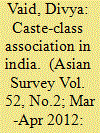| Srl | Item |
| 1 |
ID:
113205


|
|
|
|
|
| Publication |
2012.
|
| Summary/Abstract |
This paper empirically analyzes the association between caste and class in India. I find a tentative congruence between castes and classes at the extremes of the caste system and a slight weakening in this association over time. Although Scheduled Castes have low upward mobility, higher castes are not entirely protected from downward mobility.
|
|
|
|
|
|
|
|
|
|
|
|
|
|
|
|
| 2 |
ID:
147879


|
|
|
|
|
| Summary/Abstract |
This paper investigates the role played by education as a mediator of inter-generational social mobility in India. It uses a nationally representative data set (the National Election Study 2009) to describe and establish patterns of social mobility in India, and subsequently, to establish the role played by education with regard to this mobility. In particular, it attempts to test the ‘merit’ argument by analysing whether the effect of social origins (class and caste; along with locality and gender) on mobility and on gaining access to one class destination (where education is expected to be critical) has declined, and whether education plays a role. However, while the paper finds high rates of inter-generational stability, rural–urban disaggregation complicates the broader picture. The role of education is also key, especially for women. The paper finds that education plays an important role with regard to social mobility chances, but the effect of caste and class of origin remains significant. Focusing on one class destination – the professional class – once we control for education, the impact of caste seems to vary, while the role played by class of origin remains statistically significant. The implications of these patterns by gender and locality are discussed.
|
|
|
|
|
|
|
|
|
|
|
|
|
|
|
|